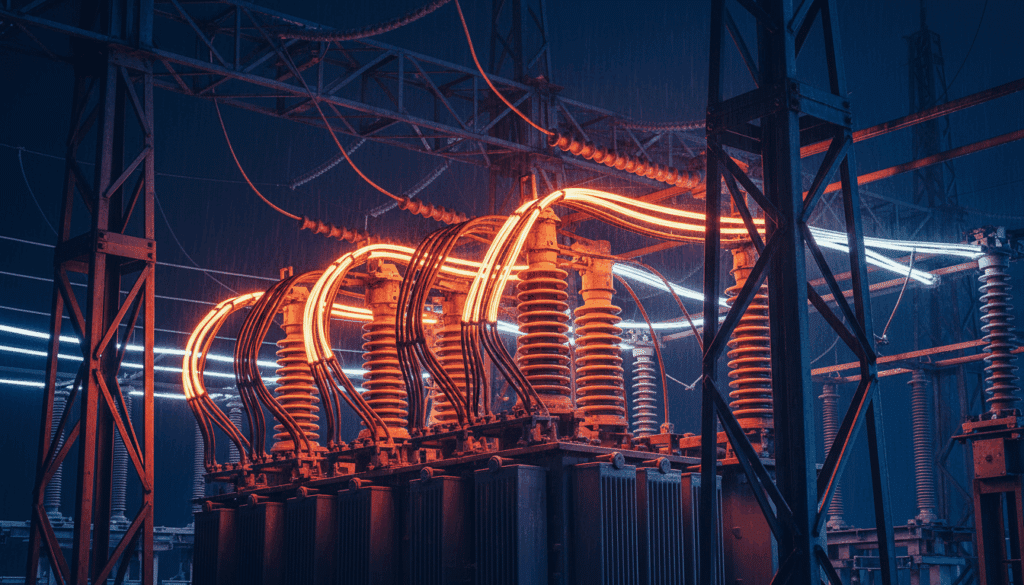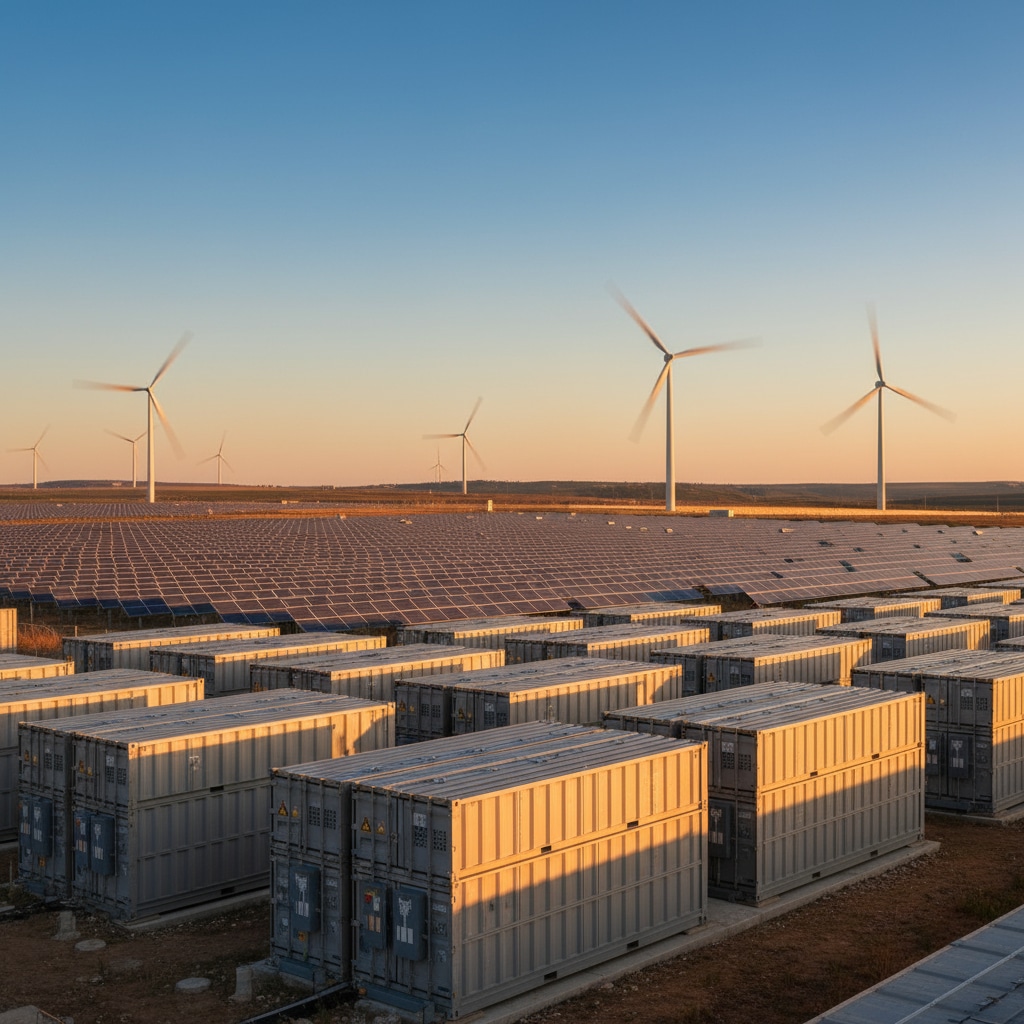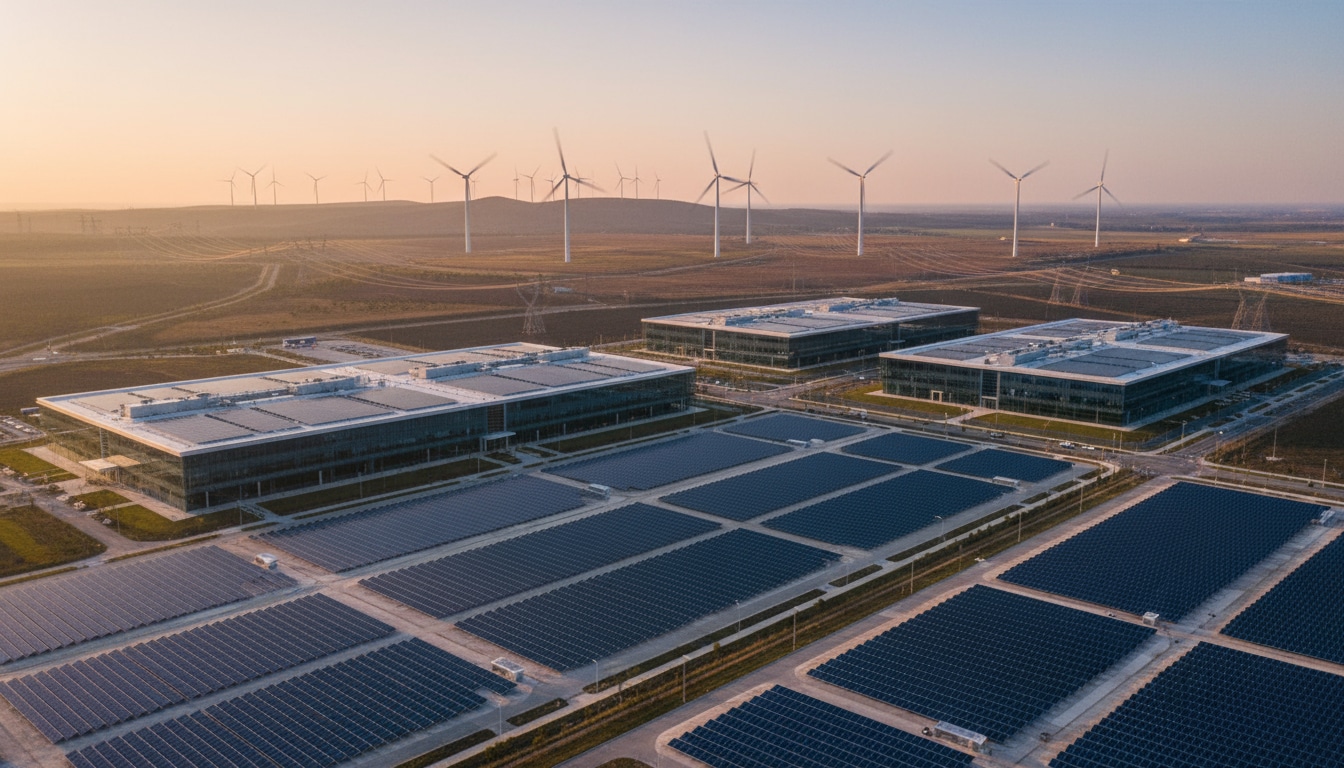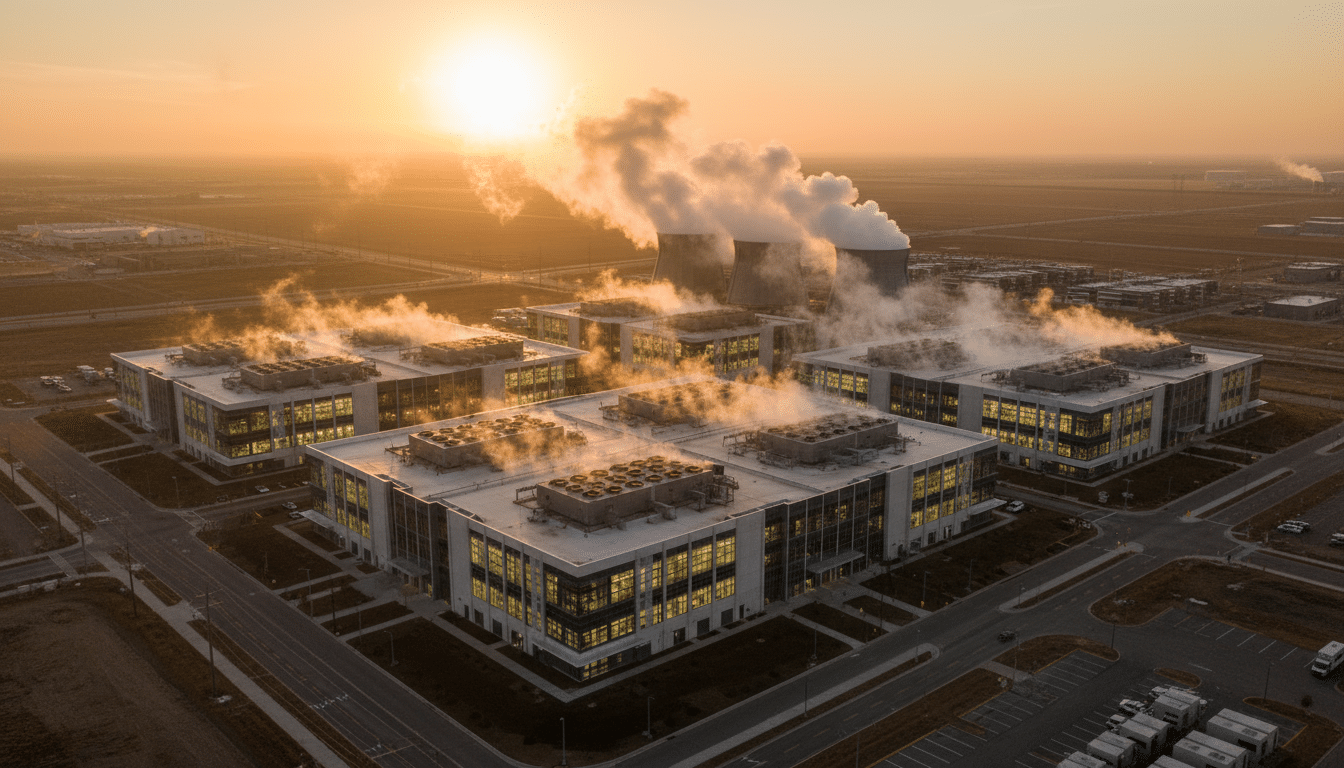Key Takeaways
Selecting energy companies for AI data centers requires evaluating power capacity, financial stability, renewable capabilities, and long-term partnership potential to ensure reliable, scalable, and sustainable operations.
- Power density requirements – AI workloads demand substantially higher power densities than traditional computing, requiring partners with massive scalability
- Financial resilience – Investment-grade ratings and substantial balance sheets essential for 10-20 year infrastructure commitments
- Renewable integration – Clean energy capabilities becoming mandatory for ESG compliance and cost stability
- Technical innovation – Partners must understand dynamic AI workloads and offer advanced solutions like microgrids and energy storage
Partner with energy companies that demonstrate proven expertise in large-scale renewable development, robust financial backing, and deep understanding of AI infrastructure requirements.
The artificial intelligence revolution has created an unprecedented energy crisis for data center operators. As AI infrastructure demands significantly more power than traditional computing, choosing the right energy companies for AI data centers has become one of the most critical strategic decisions facing technology leaders today. The International Energy Agency projects that electricity demand from data centers will more than double by 2030, with AI operations driving the majority of this explosive growth.
Unlike traditional data center partnerships where energy was often an afterthought, AI infrastructure demands require energy companies for AI data centers to be strategic partners from day one. The wrong choice can result in years of delays, cost overruns, and operational limitations that cripple an organization’s ability to compete in the AI economy. This comprehensive guide provides the framework for evaluating and selecting energy partners capable of powering next-generation AI infrastructure.
What Power Requirements Do AI Data Centers Need?
Modern AI infrastructure operates at power densities that far exceed traditional data center requirements. The fundamental shift toward GPU-intensive computing has created unprecedented demands for electrical infrastructure and cooling systems. This transformation has profound implications for partner selection.
Energy companies for AI data centers must demonstrate their ability to deliver not just initial capacity, but seamless expansion capabilities as AI demands continue growing exponentially. Goldman Sachs research indicates that data center power consumption could increase by 165% through 2030, meaning today’s energy infrastructure decisions will determine which organizations can scale their AI capabilities and which will be constrained by power limitations.

Successful sustainable AI partners typically offer modular power delivery systems that can scale from hundreds of megawatts to multi-gigawatt installations. They should provide detailed capacity roadmaps showing how additional power can be brought online as operations expand, including specific timelines and infrastructure investment requirements. The best providers maintain strategic positions near existing electrical transmission infrastructure, enabling faster deployment compared to competitors starting development from scratch.
How Do You Evaluate Energy Partner Financial Stability?
AI infrastructure projects often require substantial upfront investments and long-term financial commitments spanning 10-20 years. The boom-and-bust nature of the energy industry makes careful evaluation of financial strength and corporate backing essential for sustainable partnerships.
Reputable energy companies for AI data centers typically maintain investment-grade credit ratings, substantial balance sheet capacity, and backing from established financial institutions or major corporations. They should provide transparent financial disclosures and demonstrate experience managing complex, capital-intensive projects. Corporate backing from established entities provides additional confidence in their ability to execute long-term commitments.
Due diligence should examine the partner’s track record with similar-scale projects, their access to capital markets, and their ability to secure financing for infrastructure development. Companies with diversified revenue streams and multiple project portfolios generally present lower risk than those dependent on single projects or markets. The financial evaluation should also consider the partner’s ability to absorb cost overruns or delays without compromising project completion.
What Renewable Energy Features Should You Prioritize?
Environmental sustainability has evolved from a marketing advantage to a core business imperative for data center operators. Major technology companies now require 100% renewable energy for their AI infrastructure operations, significantly limiting the pool of qualified green energy AI partners to those with substantial renewable generation portfolios.
Critical Renewable Energy Features
- 24/7 Clean Energy Matching – Advanced providers offer hourly renewable energy matching rather than simple annual credits, ensuring AI workloads are powered by clean energy around the clock
- Diversified Generation Portfolio – The most capable green energy AI partners maintain diverse renewable assets including solar, wind, and energy storage systems with transparent carbon intensity reporting
- Co-located Generation – Innovative solutions include on-site renewable generation that directly serves data center loads without relying on grid transmission
- Energy Storage Integration – Battery energy storage systems bridge gaps between intermittent renewable generation and continuous AI power demands
- Green Hydrogen Capabilities – Next-generation providers offer green hydrogen production and storage for carbon-free backup power during extended periods of low renewable generation

Advanced Renewable Solutions
Leading energy companies for AI data centers are implementing comprehensive approaches that address intermittency concerns while maintaining reliability standards. These include hybrid power systems combining multiple renewable sources with traditional backup capabilities, strategic geographic distribution to optimize renewable energy access, and participation in renewable energy markets that create additional revenue streams while supporting grid stability.
The renewable transition requires sophisticated technical integration. Sustainable AI partners should demonstrate expertise in grid interconnection, power conditioning, and smart grid energy management systems that optimize renewable utilization while maintaining the high availability standards that AI operations demand.
What Technical Capabilities Should Energy Partners Provide?
The complexity of AI infrastructure energy systems demands partners with proven expertise in high-performance computing environments. AI workloads create unique technical challenges that differ significantly from traditional data center power requirements, including rapid power fluctuations as AI training operations scale dynamically and extreme power density management requiring specialized electrical distribution systems.
Energy companies for AI data centers must understand these technical requirements and offer solutions optimized for high-performance computing workloads. This includes higher voltage distribution systems, advanced power conditioning equipment, and intelligent load management capabilities that accommodate the variable power demands characteristic of AI operations.
Innovation capabilities separate leading providers from traditional energy companies. The most advanced partners offer microgrid capabilities that allow facilities to operate independently during grid emergencies, direct current power distribution that eliminates conversion losses, smart grid integration that enables dynamic load management, and emerging technologies like fuel cells and small modular reactors for future-proof power delivery.
| Innovation Category | Traditional Approach | AI-Optimized Solution |
| Power Distribution | Standard AC systems | High-voltage DC microgrids |
| Grid Integration | Passive consumption | Active grid participation |
| Backup Systems | Diesel generators | Green hydrogen + batteries |
| Load Management | Static capacity | Dynamic scaling systems |
How Do Location and Regulations Impact Partner Selection?
Geographic location directly impacts grid access, renewable energy availability, cooling requirements, and regulatory environments. Energy companies for AI data centers with experience across multiple regions provide more flexible deployment options and help organizations access the most favorable operating environments for their specific requirements.
Power availability varies dramatically by region, with some traditional markets like Northern Virginia and Silicon Valley facing extended timelines for new grid connections. Smart sustainable AI partners identify emerging markets with abundant power capacity and streamlined regulatory processes, enabling faster project deployment while reducing infrastructure costs.
Regulatory frameworks around sustainability reporting are becoming increasingly sophisticated and mandatory across major markets. The European Union’s Energy Efficiency Directive requires detailed energy and sustainability metrics reporting, with similar requirements developing in other regions. Partners should demonstrate experience with these compliance requirements and provide the reporting capabilities necessary for regulatory adherence.
Climate considerations also play a crucial role in partner selection. Regions with favorable renewable energy resources, supportive development policies, and minimal extreme weather risks provide more stable operating environments for long-term AI infrastructure investments. Understanding renewable energy deployment strategies across different geographic markets becomes essential for optimal site selection.
What Should AI Power Contracts Include?
Power purchase agreements for AI infrastructure differ significantly from traditional utility contracts. These agreements must address the unique characteristics of AI workloads while providing the flexibility and reliability required for mission-critical operations.
Successful AI power contracts offer flexible terms that accommodate the evolving nature of AI infrastructure requirements. This includes scalability provisions that enable capacity expansion without complete contract renegotiation, performance guarantees that ensure reliable power delivery with appropriate remedies for failures, and risk allocation frameworks that appropriately distribute responsibilities between partners.
Pricing structures should provide long-term cost visibility while maintaining competitiveness. Fixed-price agreements offer predictability but may result in higher costs over time, while variable pricing tied to energy markets provides flexibility but requires sophisticated risk management. Many AI power contracts now incorporate hybrid structures that balance predictability with market responsiveness.
The most effective partnerships extend beyond simple power delivery to include technical support, regulatory assistance, and collaborative planning for future expansion. Green energy AI companies should demonstrate their commitment to long-term partnership success through dedicated support teams, proactive communication, and transparent reporting on project milestones and performance metrics.
How Do You Vet Potential Energy Partners?
Thorough evaluation requires a systematic approach to assessing potential energy partners across multiple dimensions. The due diligence process should examine technical capabilities, financial strength, operational track record, and cultural alignment with long-term partnership objectives.
Essential Vetting Questions
Technical Capabilities:
- What is your maximum single-site power delivery capacity?
- How do you handle high-density power requirements for AI workloads?
- What backup and redundancy systems do you provide?
- How do you integrate renewable energy with reliability requirements?
Financial and Operational:
- What is your credit rating and financial backing?
- How many projects of similar scale have you completed on time and budget?
- What is your typical project timeline from commitment to energization?
- How do you handle cost overruns or construction delays?
Partnership Approach:
- What ongoing support do you provide after project completion?
- How do you handle capacity expansion requests?
- What reporting and monitoring capabilities do you offer?
- How do you manage regulatory compliance and permitting processes?
| Evaluation Criteria | Weight | Assessment Method |
| Power Capacity | 25% | Technical specifications review |
| Financial Stability | 20% | Credit analysis & references |
| Renewable Capabilities | 20% | Portfolio assessment |
| Track Record | 15% | Project case studies |
| Innovation | 10% | Technology roadmap review |
| Partnership Approach | 10% | Cultural fit assessment |
Reference checks should include conversations with existing customers, particularly those with similar AI infrastructure requirements. These discussions provide valuable insights into the partner’s operational performance, responsiveness to issues, and ability to deliver on commitments over extended periods.

How Do You Future-Proof Your Energy Partnership?
The rapid evolution of AI technology means that today’s power requirements may represent only the beginning of future energy demands. Successful energy companies for AI data centers demonstrate their ability to anticipate and accommodate technological advances while maintaining operational excellence.
Next-generation AI systems may require even higher power densities and more sophisticated cooling solutions. Partners should provide clear roadmaps for scaling their capabilities and integrating emerging technologies like advanced nuclear systems, improved energy storage, and enhanced grid services that can support the continuing growth of AI infrastructure.
The most forward-thinking sustainable AI partners are already investing in research and development programs that address future challenges. This includes collaborations with technology companies, participation in industry standards development, and pilot programs that test innovative approaches to power delivery and management. Understanding comprehensive power infrastructure requirements helps ensure partnerships can adapt to evolving technical demands.
Frequently Asked Questions
What power densities should energy systems support for AI workloads? AI infrastructure typically requires significantly higher power densities than traditional data centers. Energy partners should design systems with expansion capabilities that can accommodate increasing power densities without requiring complete infrastructure replacement as AI technology continues evolving.
How long do AI data center energy projects typically take to complete? Energy infrastructure for large-scale AI data centers typically requires 3-7 years from initial planning to full operational status. This timeline includes environmental permitting, grid interconnection, construction, and commissioning phases. Projects with existing grid connections or pre-permitted sites can significantly reduce these timelines.
What role does energy storage play in AI data center power systems? Energy storage systems provide multiple benefits including grid stability, renewable energy integration, and backup power capabilities. Large-scale battery systems can store excess renewable generation for use during peak demand periods and provide rapid response capabilities for maintaining power quality during grid disturbances.
How do renewable energy requirements impact partner selection? Many organizations now require 100% renewable energy for AI operations, significantly limiting qualified partners to those with substantial renewable portfolios and grid-scale storage capabilities. Advanced providers offer 24/7 renewable matching rather than simple annual credits, ensuring continuous clean power delivery.
Power Your AI Future with Expert Partners
Selecting the right energy companies for AI data centers requires careful evaluation of power capacity, financial stability, renewable capabilities, and long-term partnership potential. The decisions made today will determine which organizations can fully capitalize on the AI revolution and which will be constrained by inadequate energy infrastructure.
The complexity and scale of AI infrastructure demands partners who understand both the technical requirements and business implications of next-generation computing. Success requires energy companies that combine proven expertise with innovative thinking, substantial financial resources with flexible partnership approaches, and deep technical capabilities with commitment to sustainable operations.
Hanwha Data Centers brings together the expertise, resources, and renewable energy focus required for next-generation AI infrastructure development. Our integrated approach to energy solutions for data centers combines large-scale project development with comprehensive understanding of high-performance computing requirements.
Contact Hanwha Data Centers today to discover how our renewable energy solutions can power your AI infrastructure ambitions and position your organization for success in the AI-driven economy through our comprehensive data center infrastructure solutions.




